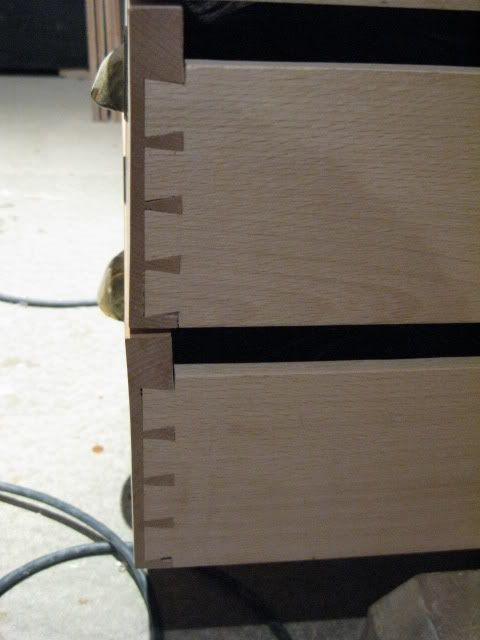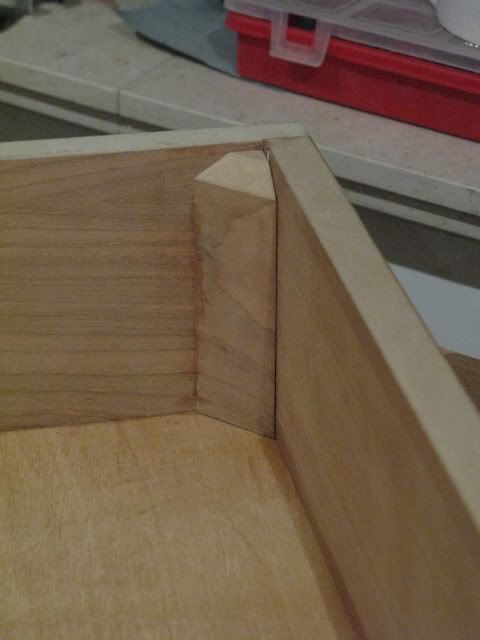|
|
Post by modernist on Dec 21, 2008 23:10:09 GMT
Contradiction in terms maybe? I am making some workshop machine stands with drawers under and am using up some offcuts of 18mm veneered MDF where possible. As they may have a fair load in them I am using 12mm ply bottoms full width with the MDF sides glued and screwed onto them and bottom fix drawer runners to take the load. The fronts and backs are biscuited into the sides and an overhung false front covers all the sins. The problem is the front/side joint. the mechanical strength of the biscuited joint is very poor owing to the short distance between the biscuit and the edge (the biscuits are central). Is there a better way. I think I will have to put glue blocks inside to stand any chance of handling heavy tooling loads without the inner fronts pulling out. The ply bottom is tounged into the front. Seems more trouble than it's worth.   Brian |
|
|
|
Post by scraper on Dec 21, 2008 23:23:35 GMT
I've made a lot of drawers for fairly decent loads in a commercial application using 12mm MDF, biscuited together at the corners, with a 9mm MDF bottom set in grooves in all four sides. The bottom was glued in all round with polyurethane adhesive, as were the biscuited corners. Bottom runners were used. At the time I though the construction was light, but they have been very successful!  |
|
|
|
Post by engineerone on Dec 21, 2008 23:30:35 GMT
brian, are you gluing the sides along side the front, or to the front??? there will be more strength if the sides are outside the front and rear due to the way in which mdf works. otherwise think about one of the lock joints which are made in the router, and specifically i think designed for mdf usage. in principal, since you are pulling the drawer along the strength of the joint, it should be very strong. paul  |
|
|
|
Post by mrgrimsdale on Dec 22, 2008 8:01:32 GMT
There are these things called dovetails which are designed for the job! What about abandoning the double front but retain the overhang; make front piece 20mm with 10mm housings for the sides (dovetailed even!) which gives you good glue area on 3 sides. Then 2 long screws through from the front into each side. Then the drawer back is housed into the sides, the sides projecting a bit further past the back Also - it's easy to find yourself over engineering - 12mm is very thick for the bottom Or - go the whole modernist hog; house the front and back into the sides. Leave the sides projecting beyond the fronts by 15 mm or so. Would make an interesting looking chest with Der Stijl overtones, and be ruthlessly practical. You could colour them red & black alternately! Then fit the bottom into drawer slips all round, for strength - takes stress off the side pieces. Or better for strength - sit the drawer sides on top of the bottom - glued and nailed up from underneath, and sit the drawers on ordinary runners rather than hanging them from sliders. |
|
|
|
Post by nickw on Dec 22, 2008 9:09:18 GMT
Brian,
As you suggest, make the bottom full width and full length and plant the sides on top of it. Just glue this joint it will be plenty strong enough. The sides and front/back then don't have to do much work and you can join them to each other any old how.
This is a variation on NK drawer design, which I have alluded to elsewhere on this forum.
|
|
|
|
Post by mooretoolsplease on Dec 22, 2008 11:18:09 GMT
Most of the drawers I make are from MDF, for the 2 sides I rebate out the bottom edge and 2 sides, then the front and back just a single rebate along the bottom edge.
Screws from the front and back into the sides, and a false front.
Looks very neat and tidy from the front, and lots of strength
|
|
|
|
Post by modernist on Dec 22, 2008 17:54:56 GMT
Yup I did a lot of that. Full width bottoms, glued into the fronts and glued/screwed up into the sides and sides over the fronts. I was a bit wary of dovetails in such brittle material but I'm beginning to think glued rebates and screws may have been better than biscuits.
I was indeed impressed and influenced by the nk discussion and I do like Der Stijl so I may get the paintpot out ;D
I think I have used too large biscuits which have weakened the joints uneccessarily - hopefully it will have all glued up solid.
Having had a look at them tonight, now the glue has gone off. they don't seem too bad. Maybe, like the policeman, I should withdraw my earlier statement ;D
cheers
Brian
|
|
|
|
Post by modernist on Dec 22, 2008 19:19:07 GMT
There are these things called dovetails which are designed for the job! I confess to a history of failures in this department   As you can see as the timber has moved under the influence of the underfloor heating the top dovetail has pulled back.  The other point is (referring to your other dovetail thread) that if you make the pins only as wide as the kerf then you are losing a bit of strength which you may need on certain jobs. Brian PS Yes I know you can see the end of the bl**dy groove for the bottom   |
|
|
|
Post by scraper on Dec 22, 2008 19:41:07 GMT
Arg....... I've woken up in a parallel universe! ;D When I dozed off we were making drawers from MDF....... Now it's got grain and dovetails! Jacob's been at it!!!  Anyway, on the size of the biscuits, you are correct, smaller ones work better. David. |
|
|
|
Post by modernist on Dec 22, 2008 20:35:58 GMT
Yes the biscuit size has it.
Re "grain" I am trying to encourage multi-tasking. ;D
Anyway at least I'm not hijacking someone elses thread.
I'll see how the next set go with smaller biscuits
cheers
Brian
|
|
woodchucker
New Member
 Known to my family as 'His Bungleness'.
Known to my family as 'His Bungleness'.
Posts: 34
|
Post by woodchucker on Dec 26, 2008 10:45:43 GMT
There are these things called dovetails which are designed for the job! I agree Mr. G. Dovetails in MDF are looked on with suspicion. Dunno why. The stuff is well dense, it machines well. It 's a bit wooly for planing, but we can use a sander. I might prefer a router and jig for d'tails in MDF, but with modern glue, I don't see why we shouldn't use 'em. They'd definetly be better'n biscuits. Jack |
|
woodchucker
New Member
 Known to my family as 'His Bungleness'.
Known to my family as 'His Bungleness'.
Posts: 34
|
Post by woodchucker on Dec 26, 2008 10:50:49 GMT
For Modernist.
That' shows the power of central heating. If a piece of oak with that grain orientation warps, then how dry does it need to be!
The drawer-bottom groove:
Just glue in a wedge-shaped bit of endgrain oak. Tap it in, let it dry and clean it up. You wun't notice it was there.
Edit:
The outside of the tree goes to the inside of the drawer - the inside of the tree goes to the outside of the drawer. Then the warp, if any, goes inward. Even on that drawer front, putting it the other way around would have meant the warp goes inward.
Just a lesson I learned some time ago. I hope it helps you Mod.
Jack
|
|
|
|
Post by mrgrimsdale on Dec 26, 2008 16:18:42 GMT
snip I confess to a history of failures in this department  Don't we all? Burn it if it's too bad!Single kerf DTs just for light-use drawers really. For boxes or heavy-duty drawers, you may need more equal tails/pinsGroove in front to lose it in the socket. In any case your grooves look to close to the bottom IMHO; all the contents of the drawer supported on a 6mm (?) ledge. Slightest heavy handling could break the bottom out. Grooves in sides; suitable for very light use, otherwise is bad practice; drawer slips much better. You could make up a stock of drawer slips in one go, to make it easier for future jobs. |
|
|
|
Post by modernist on Dec 26, 2008 23:13:52 GMT
I made those particular drawers a while ago and they do have slips so I'll have to have a look and see what I did. The timber was beech supposedly fully kiln dried from a reputable supplier but obviously required further drying. Since pausing for krimbold I have done some more work on the workshop drawers. I have made the 2nd set with smaller ( size 0) bisuits and they are much better. These drawers were designed for 50kg loads and I cannot convince myself any biscuit joint in MDF is up to that so I have put in some glue blocks in the front corners to be sure, to be sure. Although a cop out they dont look too bad. (they are still wet in the pic)  I also had a re-think in the light of some of the advice and decided to save time and lose nothing by nailing/glueing the full width bottoms as they will be supported by the runners. I also dropped the bottom edge of the inner drawer front to make a stronger lip under the groove for the front. The other thing I have discovered is the wonder of a dedicated biscuit glue pot. Came from Aldi for about £4 with 500 biscuits a bottle of PVA and a glue spreader roller and biscuit injector. the bisuits are a bit uneven but will do the job. By the time I've finished they may be half decent ;D Cheers Brian |
|
|
|
Post by modernist on Dec 26, 2008 23:17:38 GMT
For Modernist. The outside of the tree goes to the inside of the drawer - the inside of the tree goes to the outside of the drawer. Then the warp, if any, goes inward. Even on that drawer front, putting it the other way around would have meant the warp goes inward. Just a lesson I learned some time ago. I hope it helps you Mod. Jack Sounds good to me - thanks Brian |
|